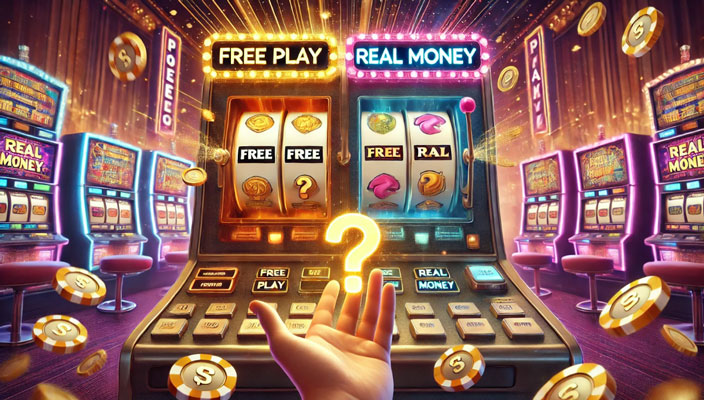The one-armed bandit slot machine is an iconic gambling device that has captivated players for over a century. What started as simple mechanical contraptions in the late 19th century has now evolved into high-tech electronic and online slot machines featuring stunning visuals, complex mechanics, and massive jackpots.
With the rise of online gambling, these classic machines have transitioned to the digital world, allowing players to experience the thrill of slots from anywhere. Platforms like Wantedwin make it easier than ever for players to access a wide range of modern slot games, offering both nostalgia and cutting-edge innovations.
In this article, we’ll take a deep dive into the history of the one-armed bandit, exploring its origins, evolution, and how it became one of the most recognizable and beloved gambling devices in casinos worldwide.
The Birth of the First Slot Machines
The earliest prototypes of slot machines appeared in the United States in the late 19th century. Unlike modern slots, these early devices didn’t always offer monetary payouts. Instead, they dispensed small prizes such as chewing gum, cigarettes, or bar drinks, depending on the symbols that appeared on the reels.
One of the first widely recognized slot machine prototypes was the Spiral Machine, created in 1891. This machine had several spinning reels displaying poker cards. Players inserted a coin and pulled a lever to start the game. If a winning poker hand appeared, they would receive a prize from the establishment where the machine was located.
Sittman and Pitt’s Poker Machine (1891)
Two American inventors, Sittman and Pitt, created one of the earliest gambling machines in New York City in 1891. Their machine was based on poker mechanics and had five drums displaying playing card symbols. Instead of paying out money, bars, and saloons rewarded winners with cigars, drinks, or other small prizes.
However, the real breakthrough in slot machine history came just a few years later with the invention of Charles Fey’s Liberty Bell machine.
Charles Fey – The Father of Modern Slot Machines
In 1895, Charles Fey, a German-born mechanic living in California, revolutionized gambling by inventing the first true slot machine, known as the Liberty Bell. Unlike earlier gambling devices, which relied on complex poker-based mechanics and required bar owners to manually distribute prizes, Fey’s machine simplified the process by introducing three spinning reels and an automatic payout system.
The Liberty Bell featured symbols such as horseshoes, stars, bells, and card suits, with the highest payout awarded for three Liberty Bell symbols in a row. This streamlined design made it more accessible and faster to play, leading to widespread popularity in bars, saloons, and gambling halls. Despite gambling restrictions in some states, the Liberty Bell’s influence couldn’t be stopped, and its design became the foundation for all future slot machines.
Slot Machines in the Early 20th Century (1900s–1950s)
In the early 20th century, slot machines continued to evolve, adapting to changes in gambling laws and technological advancements. As authorities imposed stricter regulations on gambling, manufacturers sought creative ways to keep their machines in operation without violating the law. Instead of awarding cash prizes, some machines were redesigned to dispense chewing gum or candy, a move that technically kept them legal while still maintaining the excitement of winning. This shift led to the introduction of fruit symbols, which soon became a defining feature of slot machines. Cherries, lemons, oranges, and plums weren’t just colorful decorations—they represented different flavors of gum that players could win, giving birth to what became known as “fruit machines.”
By the 1940s and 1950s, slot machines had undergone further advancements with the introduction of electromechanical components, replacing the fully mechanical systems of earlier decades. These improvements allowed for larger jackpots, more complex game mechanics, and the ability to place multi-coin bets, which increased potential winnings. As these machines became more advanced and engaging, they also became more profitable. By the mid-20th century, slot machines had firmly established themselves as one of the biggest revenue sources for casinos, paving the way for the slot gaming industry’s massive expansion in the decades to come.
The Video Slot Revolution (1970s–1980s)
By the 1970s, slot machines underwent another major transformation with the introduction of video technology, marking the beginning of the video slot revolution. Instead of relying on traditional mechanical reels, these new machines featured video screens that displayed digital symbols. This shift allowed for more creative and flexible game designs, moving away from the physical limitations of mechanical slots.
The first true video slot machine was developed in 1976 by Fortune Coin Co. in Las Vegas. Using a modified television screen to display the reels, this new design paved the way for:
- Greater flexibility in game design, allowing for more complex themes and animations.
- More symbols on the reels increase the number of possible winning combinations.
- The introduction of bonus rounds and free spins added more excitement and chances to win.
The adoption of video slots in casinos quickly gained traction, and as technology continued to advance, these machines became increasingly popular. By the 1980s, video slots were a common sight in gambling establishments, setting the stage for the digital and online slot era that would follow in the coming decades.
The Online Casino Era (1990s–2000s)
With the rapid development of the internet in the late 1990s, gambling moved into the digital space, and slot machines followed. Traditional one-armed bandits were transformed into online slots, bringing casino gaming to a global audience without the need for physical machines. Players could now enjoy their favorite slot games from home, without having to visit a land-based casino.
One of the biggest advantages of online slots is their versatility and variety. Unlike traditional slot machines, which were limited by physical space, digital slots could feature an endless number of themes, designs, and gameplay mechanics. This allowed developers to experiment with different layouts, innovative bonus features, and new ways to win.
Online slots introduced several key innovations:
- No need for physical machines, making gambling more accessible.
- Thousands of game variations offer diverse themes and unique gameplay styles.
- Progressive jackpots that grow with every bet, creating massive potential payouts.
- Bonus rounds and interactive gameplay elements add excitement and engagement.
By the early 2000s, online slots had become the most popular form of gambling on the internet, attracting millions of players worldwide. The ability to play from anywhere, at any time, combined with the introduction of secure payment methods and fair gaming regulations, made online slots a dominant force in the industry.
Modern Slot Machines and Future Innovations
Slot machines have continued to evolve into stunning digital experiences, incorporating cutting-edge technology to make gameplay more immersive and entertaining. Modern online slots feature high-quality visuals, engaging storylines, and interactive elements, making them feel more like video games than traditional gambling machines.
Some of the most significant advancements in modern slot technology include:
- 3D graphics and animations, providing a more immersive and visually appealing experience.
- Interactive bonus rounds, allowing players to unlock extra features and prizes.
- Mobile compatibility, making slots available on smartphones and tablets.
- Virtual Reality (VR) slots, with some casinos experimenting with VR technology to create fully immersive casino environments.
One of the biggest game-changers in the modern slot gaming industry is the introduction of progressive jackpots. These jackpots grow continuously as players place bets, with a small portion of each wager contributing to the overall prize pool. Some online slot jackpots have reached millions of dollars, attracting thousands of players hoping for a life-changing win.
As technology continues to advance, the future of slot machines is expected to bring even more innovation, interactivity, and realism, ensuring that the one-armed bandit remains as popular as ever in both physical and online casinos.
The One-Armed Bandit’s Cultural Impact
The one-armed bandit has transcended gambling, appearing in movies, TV shows, and pop culture references. Some of the most famous depictions include:
- Classic Las Vegas casinos filled with rows of slot machines
- Hollywood movies featuring dramatic jackpot wins
- Video games and apps that simulate slot machine gameplay
The slot machine’s iconic lever and spinning reels remain a symbol of luck, chance, and excitement, even as digital versions take over.
Conclusion
From the mechanical machines of the 19th century to the high-tech video slots of today, the one-armed bandit has remained one of the most popular gambling devices in history. Despite advancements in technology, the core excitement of spinning the reels and hoping for a big win has remained unchanged for over a century.
While the gambling industry continues to evolve, with virtual reality and blockchain-based casinos on the horizon, one thing is certain—slot machines are here to stay.
If you’re looking to explore modern online slots, many platforms offer exclusive bonuses and promotions, similar to how players seek Stay Casino promo codes for extra rewards. Whether in a traditional casino or online, the thrill of the one-armed bandit continues to entertain players worldwide.












